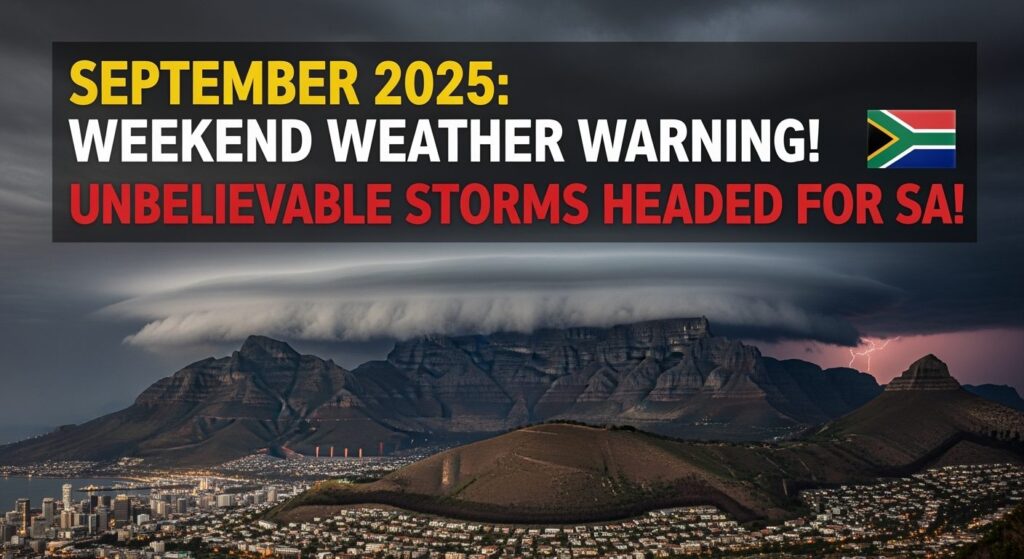South African storm warning: As we approach the September 2025 weekend, I want to alert you about a significant weather system developing that poses substantial risks to several South African provinces. Meteorological data indicates that a powerful storm front is expected to make landfall, bringing with it heavy rainfall, strong winds, and potential flooding in coastal and low-lying areas. The South African Weather Service has issued early warnings for the Eastern Cape, KwaZulu-Natal, and parts of the Western Cape, urging residents to prepare adequately. Have you started thinking about your emergency preparations yet? With climate patterns becoming increasingly unpredictable, this upcoming storm system requires our immediate attention and proactive planning.

What Makes This Storm System Dangerous
This particular South African storm warning carries special concern due to several factors that meteorologists have identified. The system is developing during a transitional season when atmospheric conditions are particularly volatile. According to preliminary models, wind speeds could reach up to 90 km/h in coastal regions, with rainfall potentially exceeding 100mm in a 24-hour period in certain areas. The combination of saturated ground from previous rainfall patterns and these intense precipitation levels creates a perfect scenario for flash flooding and landslides, especially in mountainous regions and informal settlements.
The timing of this storm also coincides with spring tides, which could exacerbate coastal flooding and erosion. Urban drainage systems in major cities like Cape Town, Durban, and Port Elizabeth may struggle to cope with the volume of water, potentially leading to widespread urban flooding. The South African Weather Service has emphasized that this storm’s trajectory and intensity make it notably different from typical seasonal weather patterns.
Why Preparation Is Critical
When facing a South African storm warning of this magnitude, preparation becomes your most valuable defense. Historical data from similar weather events shows that proactive measures can significantly reduce injury, property damage, and loss of life. The 2023 floods in KwaZulu-Natal demonstrated how quickly conditions can deteriorate when severe weather strikes populated areas. Those communities that had emergency plans in place fared considerably better than unprepared regions.
Climate scientists have been monitoring the increasing frequency and intensity of storm systems affecting South Africa’s coastal provinces. This trend is consistent with climate change predictions for the region, suggesting that such extreme weather events may become more common. By taking this September 2025 warning seriously, you’re not only protecting yourself for this specific event but also developing resilience for a future where such storms may occur with greater regularity. Remember that government resources can become quickly overwhelmed during widespread emergencies.
How to Prepare for the Storm
Preparing for this approaching storm requires a multi-faceted approach that addresses both immediate safety concerns and potential aftermath challenges. I recommend starting with securing your property by clearing gutters, trimming dangerous branches, and reinforcing any vulnerable structures. Create an emergency kit containing essential supplies for at least 72 hours, including non-perishable food, water (at least 3 liters per person per day), medications, first aid supplies, flashlights, and batteries.
- Develop a family emergency communication plan with meeting points and emergency contacts
- Prepare for potential power outages with alternative lighting and charging options
- Secure important documents in waterproof containers
- Monitor official weather updates and emergency broadcasts continuously
If you live in a flood-prone area, consider temporary flood barriers and know your evacuation route. For those in informal settlements, community coordination becomes especially important – identify sturdy structures where people can shelter and establish early warning systems within your community. Don’t forget to include plans for pets and livestock in your preparations.
 Youth Support R12,500 Grant September 2025 – Young South Africans Can Apply From This Week
Youth Support R12,500 Grant September 2025 – Young South Africans Can Apply From This Week
When to Take Action
The timeline for this storm system requires immediate attention, with different actions needed at various stages. I advise beginning your preparations immediately, as supply shortages often occur in the days just before a major weather event. The most intense period of the storm is currently predicted to affect the Eastern Cape beginning Friday evening, September 12, 2025, before moving northeast to KwaZulu-Natal throughout Saturday and Sunday. Western Cape residents should anticipate impacts starting as early as Friday morning.
Pay close attention to evacuation notices, which may be issued 24-48 hours before the storm’s arrival in high-risk areas. If you’re in a vulnerable location, consider voluntary evacuation before conditions deteriorate and roads become impassable. Remember that nighttime evacuations are particularly dangerous, so make decisions with ample daylight remaining. After the storm passes, remain cautious – some of the most serious injuries occur during the cleanup phase when people return to damaged structures or encounter downed power lines.
Real-World Lessons from Previous Storms
During the 2021 coastal storms that struck the Eastern Cape, the small community of Mzamba demonstrated the power of preparedness. Community leader Thembeka Ndlovu organized a neighborhood watch system where designated individuals monitored water levels in the nearby river and coordinated with local authorities. When the storm intensified, their early warning system gave residents precious extra hours to move to higher ground, resulting in zero casualties despite significant property damage. Their community WhatsApp group became an essential communication tool when cell towers were intermittently functional, allowing them to share resources and information efficiently during the recovery period.




